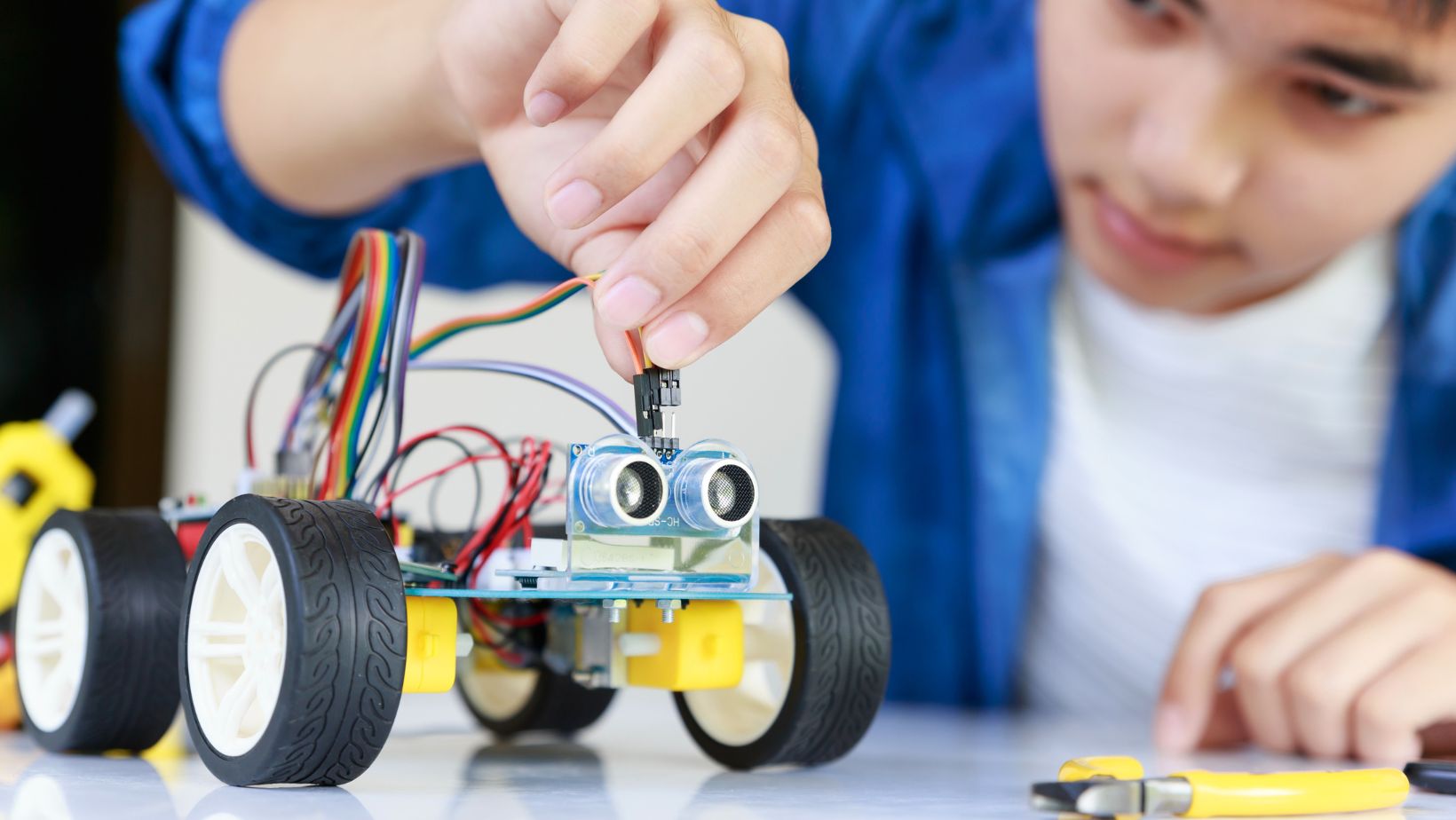Key Takeaways
- Robotics Education Importance: Engaging in robotics classes equips students with critical skills in programming, engineering, and problem-solving, essential for future careers in a tech-driven world.
- Hands-On Learning: Robotics classes emphasize practical projects that allow students to apply theoretical knowledge, fostering a deeper understanding of concepts through real-world applications.
- Teamwork and Collaboration: Many programs promote working in teams, enhancing communication skills and cultivating a sense of community among participants.
- Career Preparation: Exposure to robotics opens various career pathways in STEM fields, including engineering, computer science, and technology development.
- Flexible Learning Formats: Robotics classes are available in diverse formats, such as online courses and in-person workshops, accommodating different learning preferences and schedules.
- Future Trends: Advancements in technology, such as AI integration and interdisciplinary learning approaches, are shaping the future of robotics education, enhancing the learning experience for students.
In a world increasingly driven by technology, robotics classes offer an exciting gateway into the future. These programs not only spark creativity but also equip students with essential skills in programming, engineering, and problem-solving. As industries evolve, understanding robotics becomes crucial for the next generation.
Students of all ages can dive into hands-on projects that make learning enjoyable and practical. From building simple machines to programming complex algorithms, robotics classes foster a collaborative environment where innovation thrives. Embracing robotics education today prepares learners for tomorrow’s challenges and opportunities in a tech-centric landscape.
Robotics Classes
Robotics classes offer structured learning environments that focus on developing skills in technology, engineering, and teamwork. These classes cater to various age groups, from young children to adults, making robotics education accessible for everyone.
Key Components of Robotics Classes
- Curriculum: Robotics classes typically include topics like programming languages, electronics, mechanics, and design principles. This diverse curriculum empowers students to understand the multifaceted nature of robotics.
- Hands-On Projects: Engaging in hands-on projects allows students to apply theoretical knowledge in practical situations. Building robots, programming them, and troubleshooting issues reinforce learning through experience.
- Collaboration: Many robotics classes emphasize teamwork. Students often work in groups to complete projects, enhancing communication skills and fostering a sense of community.
- Competitions: Robotics competitions provide additional motivation. Classes often prepare students for local, national, or international contests where they can showcase their skills and creativity.
- Technology Integration: Robotics education incorporates current technologies such as sensors, artificial intelligence, and machine learning. Understanding these technologies prepares students for future careers in various fields.
- Skill Development: Robotics classes help students develop technical skills in coding, building, and problem-solving, essential for careers in engineering and technology.
- Creativity Boost: Students exercise creativity while designing and programming robots, enabling innovative thinking that extends beyond robotics.
- Career Preparation: Exposure to robotics equips students with skills that match job market demands, enhancing employability in a technology-driven society.
- STEM Engagement: Robotics engages students in Science, Technology, Engineering, and Mathematics (STEM), stimulating interest in these critical areas.
Robotics classes serve as a vital educational tool, fostering essential skills and preparing students for future technological advancements.
Benefits of Taking Robotics Classes
Robotics classes offer numerous benefits, particularly in skill development and career opportunities. These programs equip students with important abilities that are applicable in various fields.
Skills Development
Robotics classes foster critical skills essential for modern careers. Participants enhance their knowledge of programming languages, electronics, and mechanical design.
- Problem Solving: Students tackle complex challenges during hands-on projects, building analytical thinking.
- Creativity: Designing and building robots encourages original thoughts and innovative solutions.
- Collaboration: Working in teams improves communication and teamwork, vital in any workplace.
- Technical Proficiency: Familiarity with current technologies, such as artificial intelligence and sensors, prepares students for future advancements.
- Adaptability: Students learn to adjust to new tools and techniques, cultivating flexibility in learning.
Career Opportunities
Robotics classes broaden career pathways across various industries. Knowledge in robotics opens doors to STEM fields such as engineering, computer science, and technology.
- Engineering Roles: Graduates find opportunities in mechanical, electrical, and software engineering.
- Technology Development: Robotics expertise leads to positions in automation and robotics systems design.
- Research Positions: Knowledge in robotics supports careers in research and development, focusing on new technologies.
- Education: Skills gained allow individuals to become educators in robotics and technology domains.
- Entrepreneurship: Understanding robotics can inspire students to create innovative startups in tech-driven markets.
Types of Robotics Classes

Robotics classes come in various formats, each designed to cater to different learning preferences and needs. The two primary types include online robotics courses and in-person robotics workshops.
Online Robotics Courses
Online robotics courses provide flexibility and accessibility for learners worldwide. These courses often include video lectures, interactive tutorials, and virtual labs, allowing students to learn at their own pace. Popular platforms offer structured programs that cover essential topics like programming languages, electronics, and robotics theory. For example, platforms like Coursera and edX present university-level content that students can access from home. Additionally, learners may engage in community forums for collaboration and problem-solving. These courses provide a conducive environment for self-motivated individuals seeking to develop their skills remotely.
In-Person Robotics Workshops
In-person robotics workshops offer hands-on experiences that foster teamwork and collaboration. Students participate in group projects where they design, build, and program robots using various materials and tools. Workshops typically focus on specific themes, such as drone programming or robotic competitions, allowing participants to deepen their expertise in particular areas. These sessions often feature guidance from experienced instructors who provide real-time feedback. Local organizations, schools, and maker spaces frequently host workshops, creating opportunities for community engagement. The interactive nature of in-person workshops enhances learning retention and inspires creativity among participants.
Choosing the Right Robotics Class
Selecting the appropriate robotics class involves considering various factors that align with personal goals and learning preferences. Understanding these aspects ensures an enriching educational experience.
Factors to Consider
- Age Group: Identify classes tailored for specific age ranges, such as primary school, middle school, or high school students. Programs designed for different ages often vary in complexity and content focus.
- Skill Level: Assess existing knowledge in robotics or related fields. Beginners may benefit from foundational courses, while advanced learners may seek specialized topics or challenges.
- Learning Format: Choose between online and in-person formats based on personal preference. Online courses provide flexibility, while in-person classes emphasize hands-on experiences and real-time collaboration.
- Curriculum Focus: Evaluate the curriculum’s emphasis, whether on programming, electronics, mechanical design, or interdisciplinary approaches. Classes that cover various aspects may provide a more holistic understanding of robotics.
- Instructor Credentials: Research instructors’ backgrounds and expertise. Experienced instructors can offer better insights and mentorship, enhancing the overall learning experience.
- Class Size: Consider class sizes, as smaller groups may allow for personalized instruction and closer interactions with peers and instructors.
- Cost: Examine program costs against budget constraints. Availability of scholarships or financial aid can also impact decision-making.
- Online Platforms: Websites like Coursera, edX, and Udemy feature a variety of robotics courses covering programming, electronics, and design. These platforms cater to different skill levels and learning styles.
- Local Community Colleges: Many community colleges offer robotics classes, often featuring hands-on workshops and expert instruction. These programs often focus on practical applications and collaboration.
- Robotics Competitions: Participating in competitions like FIRST Robotics or VEX Robotics provides valuable experience and enhances skills through real-world applications and teamwork.
- Books and Guides: Resources such as “”Robotics for Dummies”” and “”Making Robots with LEGO Mindstorms”” can supplement learning and offer insights into various robotics concepts and projects.
- Online Forums: Engaging with communities on platforms like Reddit or specialized robotics forums can provide support and recommendations. Connecting with peers and mentors fosters growth and resource sharing.
Future Trends in Robotics Education

Robotics education continues to evolve, reflecting advancements in technology and changes in industry demands. Emerging trends indicate a greater focus on personalized learning experiences that cater to individual student needs. Students engage with customized curricula, enabling them to progress at their own pace and explore areas of interest deeply.
Integration of artificial intelligence in robotics classes enhances learning outcomes. AI-driven tools provide real-time feedback to learners, facilitating improvement and encouraging experimentation. Students increasingly interact with intelligent bots to develop programming skills and expand their understanding of machine learning principles.
Collaboration with industry partners shapes robotics education’s future trajectory. Educational institutions forge partnerships with tech companies, ensuring that curricula align with current industry trends and job market demands. Students benefit through exposure to real-world projects and internships, gaining relevant experiences that prepare them for career pathways in robotics and automation.
Expansion of robotics competitions promotes a hands-on approach to learning. Competitions foster creativity, problem-solving, and teamwork while allowing students to apply knowledge in high-pressure environments. These events also instill critical soft skills that employers value, such as effective communication and collaboration.
Increased emphasis on interdisciplinary learning integrates robotics with fields like mathematics, science, and art. Students experience holistic education approaches, linking concepts across disciplines. Such integration enhances creativity and innovation, equipping learners with a broad skill set essential for future careers.
Diverse learning formats, including virtual reality, gamification, and augmented reality, reshape how students engage with robotics concepts. Immersive technologies create interactive environments that enhance understanding and retention of complex topics. Students enjoy an engaging and dynamic learning experience that fosters motivation and deeper comprehension.
Career Readiness for Robotics
Robotics classes play a crucial role in shaping the future of education and career readiness. They not only equip students with essential technical skills but also foster creativity and collaboration. As technology continues to evolve, these programs prepare learners to meet emerging challenges head-on.
With a variety of class formats available, students can find the perfect fit for their learning style and goals. The integration of real-world applications and industry trends ensures that participants remain competitive in a rapidly changing job market.
Investing in robotics education today means empowering the innovators of tomorrow. Embracing this opportunity can lead to exciting career pathways and a deeper understanding of the tech-driven world.

